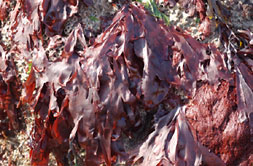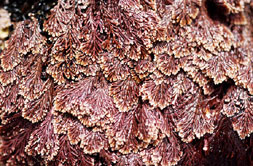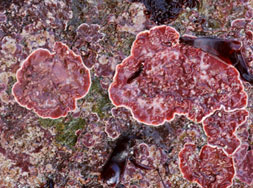Rhodophyta: Red algae
Examples: Palmaria, Delesseria, Chondrus, Coralline algae
 Characteristics: The red colour of these algae results from the pigments phycoerythrin and phycocyanin; this masks the other pigments, Chlorophyll a (no Chlorophyll b), beta-carotene and a number of unique xanthophylls. The main reserves are typically floridean starch, and floridoside; true starch like that of higher plants and green algae is absent. The walls are made of cellulose and agars and carrageenans, both long-chained polysaccharide in widespread commercial use. There are some unicellular representatives of diverse origin; more complex thalli are built up of filaments.
Characteristics: The red colour of these algae results from the pigments phycoerythrin and phycocyanin; this masks the other pigments, Chlorophyll a (no Chlorophyll b), beta-carotene and a number of unique xanthophylls. The main reserves are typically floridean starch, and floridoside; true starch like that of higher plants and green algae is absent. The walls are made of cellulose and agars and carrageenans, both long-chained polysaccharide in widespread commercial use. There are some unicellular representatives of diverse origin; more complex thalli are built up of filaments.
A very important group of red algae is the coralline algae, which secrete calcium carbonate onto the surface of their cells. Some of these corallines are articulated (right, Corallina, with flexible erect branches; others are crustose (below). These corallines have been used in bone-replacement therapies. Coralline algae were used in ancient times as vermifuges, thus the binomial Corallina officinalis.
their cells. Some of these corallines are articulated (right, Corallina, with flexible erect branches; others are crustose (below). These corallines have been used in bone-replacement therapies. Coralline algae were used in ancient times as vermifuges, thus the binomial Corallina officinalis.
Several red algae are eaten: best known amongst these is dulse (Palmaria palmata above) and Carrageen Moss (Chondrus crispus and Mastocarpus stellatus).
H owever, Nori, popularised by the Japanese is the single most valuable marine crop grown by aquaculture with a value in excess of US$1 billion. More information on aquaculture.
owever, Nori, popularised by the Japanese is the single most valuable marine crop grown by aquaculture with a value in excess of US$1 billion. More information on aquaculture.
The red algae Kappaphycus and Betaphycus are now the most important sources of carrageenan, a commonly used ingredient in food, particuarly yoghurts, chocolate milk and repared puddings. Gracilaria, Gelidium, Pterocladia and other red algae are used in the manufacture of the all-important agar, used widely as a growth medium for microorganisms, and for food and biotechnological applications.
AlgaeBase dynamic species counts shows that there are about 10,000 species of seaweeds, of which about 6,500 are red algae (Rhodophyta), the vast majority of which are marine. These are found in the intertidal and in the subtidal to depths of up to 40, or occasionally, 250 m. The main biomass of red algae worldwide is provided by the Corallinaceae and Gigartinaceae.
Back to index page





